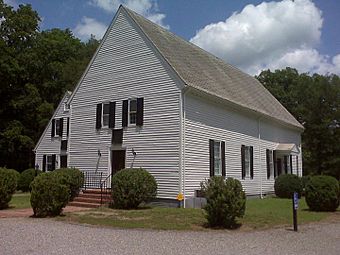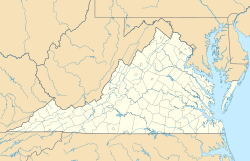Slash Church facts for kids
|
Slash Church
|
|

The church in 2013
|
|
| Location | VA 656, N of jct. with VA 657, near Ashland, Virginia |
|---|---|
| Area | 10 acres (4.0 ha) |
| Built | 1729 |
| NRHP reference No. | 72001399 |
Quick facts for kids Significant dates |
|
| Added to NRHP | September 22, 1972 |
Slash Church is a very old church in Ashland, Virginia, in Hanover County, Virginia. It's also known as the Upper Church-St. Paul's Parish. This historic building was first an Anglican/Episcopal church. Today, it is a Disciples of Christ church.
The church was built between 1729 and 1730. It was made from southern yellow pine trees. These trees were cut right from the land where the church stands. Slash Church is special because it is the oldest wooden church still used in Virginia.
Contents
History of Slash Church
Building the Church
Slash Church was built in 1729. Edward Chambers and Thomas Pinchbeck led the building work. Before this church, there was an older chapel nearby. It was called the "Mechumps Creek Chapel" and was built around 1702. That older building was about a mile and a half north of where Slash Church is now.
The name "Slash" comes from the land. There are "slashes," which are small valleys or ravines. These form in the sandy clay soil after rain. Pine trees also grew in these "slashes." The church was built on a hill because the ground water level was high.
Famous Visitors
Many important people are believed to have visited Slash Church. George Whitfield, a founder of Methodism, may have preached there. Francis Asbury, another Methodist leader, also visited. So did Reuben Ford, a Virginia Baptist, and Alexander Campbell, who started the Disciples of Christ.
Patrick Henry, a famous founding father, sometimes attended the church. His uncle, Rev. Patrick Henry, was the minister there for 40 years. However, Patrick Henry's mother was a dissenter, meaning she belonged to a different church group. He also went to Polegreen Church, a Presbyterian meetinghouse nearby. Dolley Madison and Henry Clay, who were also important figures in American history, are thought to have attended this church too.
Changes Over Time
After the American Revolutionary War, the Anglican church was no longer supported by taxes. This meant the church building was sometimes empty. Different church groups used it, including Methodists and Disciples of Christ. It was also used as a school for a while.
The Disciples of Christ group bought the church property in 1842. The Episcopal congregation built a new brick church about four miles away. That church later burned down. They then built another wooden church in the 1850s, which they still use today.
The Civil War and Slash Church
During the American Civil War, Slash Church played a role. On May 26–27, 1862, Confederate General Lawrence O'Bryan Branch used the church as his headquarters. He had about 4,500 soldiers with him. Later, the church was used as a hospital for wounded soldiers.
Two battles, sometimes called the "Battle of Slash Church," happened nearby. Union forces won these battles. When old trees were cut down in the 1950s, bullets were found in them. These bullets were likely from those Civil War battles.
Celebrating History
Slash Church celebrates its long history with special events. Every five years, they hold an event on the church grounds. In 2014, the church celebrated its 285th anniversary. The public is welcome to attend services and events. You can also schedule historic tours to learn more.
Architecture of Slash Church
Building Materials and Design
Slash Church is a one-story building with a steep roof. It is covered in white wooden boards called clapboards. The building is about 60 feet long and 26 feet wide. It was built using timber from the property, mostly Southern Yellow pine trees. These trees were often 120 feet tall. The parts of the church were held together mostly with wooden pegs.
The wooden clapboards on three sides of the church are original. Some clapboards on the north side were replaced in 1970 after a small fire. Inside, the wainscoting (wooden panels on the lower part of the walls) on one side is original. This wainscoting is special because it uses wide boards placed horizontally, not vertically.
Original Features
You can still see original wavy glass in several of the windows. These windows have their original wooden frames. A gallery, which is like a balcony, is at the back of the main church room. This gallery, its pillars, railings, and stairs are all original. You can even see how it was built by looking under the stairs.
The church also has two original slat benches. Other old furniture dates back to the 1850s. This includes a heavy, dark wooden pulpit, an oval table used for communion, and two tall chairs with padded seats. There are also different styles of wooden bench seats.
Discoveries and Additions
In the 1970s, a fire caused a lot of smoke inside the church. Firefighters cut away the floor to let the smoke out. They found another floor underneath! The builders had added a second floor because the first one was too low. The firefighters also removed the first floor. It was a very cold night, and the water from their hoses froze. So, this wood was used for a bonfire. However, church members saved some of the wood. They used it to make furniture and small items to help pay for repairs. Some of these items are in the church's history room.
When both floors were removed, four graves of unknown people were found underneath. These people are still unknown today. The second floor had blood on it from 1862. This was from the Civil War soldiers who were treated there after the battle.
Modern Facilities
A Sunday School building was added to the church. It looks similar to the church and is connected by a passageway. This was important because it did not change the historic church building itself. In the 1970s, a fellowship hall and more Sunday school rooms were built across the parking lot. These brick buildings help serve the needs of the church members today.
Slash Church was recognized as an important historical site in 1972. It was listed on the National Register of Historic Places. In 1998, a historical highway marker was placed near the church. It helps people find the church and learn about its history.



